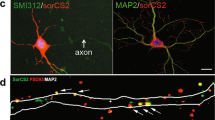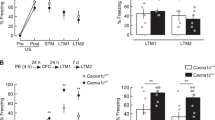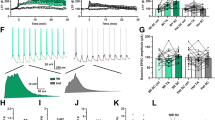Abstract
SorCS2 is a member of the Vps10p-domain receptor gene family receptors with critical roles in the control of neuronal viability and function. Several genetic studies have suggested SORCS2 to confer risk of bipolar disorder, schizophrenia and attention deficit-hyperactivity disorder. Here we report that hippocampal N-methyl-d-aspartate receptor-dependent synaptic plasticity is eliminated in SorCS2-deficient mice. This defect was traced to the ability of SorCS2 to form complexes with the neurotrophin receptor p75NTR, required for pro-brain-derived neurotrophic factor (BDNF) to induce long-term depression, and with the BDNF receptor tyrosine kinase TrkB to elicit long-term potentiation. Although the interaction with p75NTR was static, SorCS2 bound to TrkB in an activity-dependent manner to facilitate its translocation to postsynaptic densities for synaptic tagging and maintenance of synaptic potentiation. Neurons lacking SorCS2 failed to respond to BDNF by TrkB autophosphorylation, and activation of downstream signaling cascades, impacting neurite outgrowth and spine formation. Accordingly, Sorcs2–/– mice displayed impaired formation of long-term memory, increased risk taking and stimulus seeking behavior, enhanced susceptibility to stress and impaired prepulse inhibition. Our results identify SorCS2 as an indispensable coreceptor for p75NTR and TrkB in hippocampal neurons and suggest SORCS2 as the link between proBDNF/BDNF signaling and mental disorders.
This is a preview of subscription content, access via your institution
Access options
Subscribe to this journal
Receive 12 print issues and online access
$259.00 per year
only $21.58 per issue
Buy this article
- Purchase on Springer Link
- Instant access to full article PDF
Prices may be subject to local taxes which are calculated during checkout





Similar content being viewed by others
References
Hartz SM, Pato CN, Medeiros H, Cavazos-Rehg P, Sobell JL, Knowles JA et al. Comorbidity of severe psychotic disorders with measures of substance use. JAMA Psychiatry 2014; 71: 248–254.
Manji HK, Drevets WC, Charney DS . The cellular neurobiology of depression. Nat Med 2001; 7: 541–547.
Schloesser RJ, Martinowich K, Manji HK . Mood-stabilizing drugs: mechanisms of action. Trends Neurosci 2012; 35: 36–46.
Lopez AD, Murray CC . The global burden of disease, 1990–2020. Nat Med 1998; 4: 1241–1243.
Nagappan G, Lu B . Activity-dependent modulation of the BDNF receptor TrkB: mechanisms and implications. Trends Neurosci 2005; 28: 464–471.
Pang PT, Teng HK, Zaitsev E, Woo NT, Sakata K, Zhen S et al. Cleavage of proBDNF by tPA/plasmin is essential for long-term hippocampal plasticity. Science 2004; 306: 487–491.
Woo NH, Teng HK, Siao CJ, Chiaruttini C, Pang PT, Milner TA et al. Activation of p75NTR by proBDNF facilitates hippocampal long-term depression. Nat Neurosci 2005; 8: 1069–1077.
Redondo RL, Morris RG . Making memories last: the synaptic tagging and capture hypothesis. Nat Rev Neurosci 2011; 12: 17–30.
Meyer-Franke A, Wilkinson GA, Kruttgen A, Hu M, Munro E, Hanson MG Jr et al. Depolarization and cAMP elevation rapidly recruit TrkB to the plasma membrane of CNS neurons. Neuron 1998; 21: 681–693.
Ji Y, Pang PT, Feng L, Lu B . Cyclic AMP controls BDNF-induced TrkB phosphorylation and dendritic spine formation in mature hippocampal neurons. Nat Neurosci 2005; 8: 164–172.
Lu Y, Ji Y, Ganesan S, Schloesser R, Martinowich K, Sun M et al. TrkB as a potential synaptic and behavioral tag. J Neurosci 2011; 31: 11762–11771.
Deinhardt K, Kim T, Spellman DS, Mains RE, Eipper BA, Neubert TA et al. Neuronal growth cone retraction relies on proneurotrophin receptor signaling through Rac. Sci Signal 2011; 4: ra82.
Glerup S, Olsen D, Vaegter CB, Gustafsen C, Sjoegaard SS, Hermey G et al. SorCS2 regulates dopaminergic wiring and is processed into an apoptotic two-chain receptor in peripheral glia. Neuron 2014; 82: 1074–1087.
Willnow TE, Petersen CM, Nykjaer A . VPS10P-domain receptors—regulators of neuronal viability and function. Nat Rev Neurosci 2008; 9: 899–909.
Glerup S, Nykjaer A, Vaegter CB . Sortilins in neurotrophic factor signaling. Handb Exp Pharmacol 2014; 220: 165–189.
Nielsen MS, Keat SJ, Hamati JW, Madsen P, Gutzmann JJ, Engelsberg A et al. Different motifs regulate trafficking of SorCS1 isoforms. Traffic 2008; 9: 980–994.
Nielsen MS, Madsen P, Christensen EI, Nykjaer A, Gliemann J, Kasper D et al. The sortilin cytoplasmic tail conveys Golgi-endosome transport and binds the VHS domain of the GGA2 sorting protein. EMBO J 2001; 20: 2180–2190.
Vaegter CB, Jansen P, Fjorback AW, Glerup S, Skeldal S, Kjolby M et al. Sortilin associates with Trk receptors to enhance anterograde transport and neurotrophin signaling. Nat Neurosci 2011; 14: 54–61.
Baum AE, Akula N, Cabanero M, Cardona I, Corona W, Klemens B et al. A genome-wide association study implicates diacylglycerol kinase eta (DGKH) and several other genes in the etiology of bipolar disorder. Mol Psychiatry 2008; 13: 197–207.
Ollila HM, Soronen P, Silander K, Palo OM, Kieseppa T, Kaunisto MA et al. Findings from bipolar disorder genome-wide association studies replicate in a Finnish bipolar family cohort. Mol Psychiatry 2009; 14: 351–353.
Christoforou A, McGhee KA, Morris SW, Thomson PA, Anderson S, McLean A et al. Convergence of linkage, association and GWAS findings for a candidate region for bipolar disorder and schizophrenia on chromosome 4p. Mol Psychiatry 2011; 16: 240–242.
Alemany S, Ribases M, Vilor-Tejedor N, Bustamante M, Sanchez-Mora C, Bosch R et al. New suggestive genetic loci and biological pathways for attention function in adult attention-deficit/hyperactivity disorder. Am J Med Genet B 2015; 168: 459–470.
Cross-Disorder Group of the Psychiatric Genomics C. Identification of risk loci with shared effects on five major psychiatric disorders: a genome-wide analysis. Lancet 2013; 381: 1371–1379.
Cross-Disorder Group of the Psychiatric Genomics C Cross-Disorder Group of the Psychiatric Genomics C Lee SH Cross-Disorder Group of the Psychiatric Genomics C Ripke S Cross-Disorder Group of the Psychiatric Genomics C Neale BM Cross-Disorder Group of the Psychiatric Genomics C Faraone SV Cross-Disorder Group of the Psychiatric Genomics C Purcell SM et al. Genetic relationship between five psychiatric disorders estimated from genome-wide SNPs. Nat Genet 2013; 45: 984–994.
Castren E, Rantamaki T . The role of BDNF and its receptors in depression and antidepressant drug action: Reactivation of developmental plasticity. Dev Neurobiol 2010; 70: 289–297.
Martinowich K, Manji H, Lu B . New insights into BDNF function in depression and anxiety. Nat Neurosci 2007; 10: 1089–1093.
Rybakowski JK . BDNF gene: functional Val66Met polymorphism in mood disorders and schizophrenia. Pharmacogenomics 2008; 9: 1589–1593.
Okada T, Hashimoto R, Numakawa T, Iijima Y, Kosuga A, Tatsumi M et al. A complex polymorphic region in the brain-derived neurotrophic factor (BDNF) gene confers susceptibility to bipolar disorder and affects transcriptional activity. Mol Psychiatry 2006; 11: 695–703.
Hosang GM, Uher R, Keers R, Cohen-Woods S, Craig I, Korszun A et al. Stressful life events and the brain-derived neurotrophic factor gene in bipolar disorder. J Affect Disord 2010; 125: 345–349.
Cheah SY, Lawford BR, Young RM, Connor JP, Phillip Morris C, Voisey J . BDNF SNPs are implicated in comorbid alcohol dependence in schizophrenia but not in alcohol-dependent patients without schizophrenia. Alcohol Alcohol 2014; 49: 491–497.
Nees F, Witt SH, Dinu-Biringer R, Lourdusamy A, Tzschoppe J, Vollstadt-Klein S et al. BDNF Val66Met and reward-related brain function in adolescents: role for early alcohol consumption. Alcohol 2015; 49: 103–110.
Moncada D, Viola H . Induction of long-term memory by exposure to novelty requires protein synthesis: evidence for a behavioral tagging. J Neurosci 2007; 27: 7476–7481.
Fadok JP, Dickerson TM, Palmiter RD . Dopamine is necessary for cue-dependent fear conditioning. J Neurosci 2009; 29: 11089–11097.
Lu B, Pang PT, Woo NH . The yin and yang of neurotrophin action. Nat Rev Neurosci 2005; 6: 603–614.
Deinhardt K, Kim T, Spellman DS, Mains RE, Eipper BA, Neubert TA et al. Neuronal growth cone retraction relies on proneurotrophin receptor signaling through Rac. Sci Signal 2011; 4, ra82.
Zhang D, Zhang J, Bian C, Deng Q . Postnatal and ovariectomic regulation of postsynaptic density protein-95 in the hippocampus of female Sprague–Dawley rats. Synapse 2010; 64: 875–878.
Messaoudi E, Ying SW, Kanhema T, Croll SD, Bramham CR . Brain-derived neurotrophic factor triggers transcription-dependent, late phase long-term potentiation in vivo. J Neurosci 2002; 22: 7453–7461.
Pang PT, Teng HK, Zaitsev E, Woo NT, Sakata K, Zhen SH et al. Cleavage of proBDNF by tPA/plasmin is essential for long-term hippocampal plasticity. Science 2004; 306: 487–491.
Suzuki S, Numakawa T, Shimazu K, Koshimizu H, Hara T, Hatanaka H et al. BDNF-induced recruitment of TrkB receptor into neuronal lipid rafts: roles in synaptic modulation. J Cell Biol 2004; 167: 1205–1215.
Frey U, Morris RGM . Synaptic tagging and long-term potentiation. Nature 1997; 385: 533–536.
Lu Y, Ji YY, Ganesan S, Schloesser R, Martinowich K, Sun M et al. TrkB as a potential synaptic and behavioral tag. J Neurosci 2011; 31: 11762–11771.
Wang SH, Redondo RL, Morris RGM . Relevance of synaptic tagging and capture to the persistence of long-term potentiation and everyday spatial memory. Proc Natl Acad Sci USA 2010; 107: 19537–19542.
Minichiello L, Korte M, Wolfer D, Kuhn R, Unsicker K, Cestari V et al. Essential role for TrkB receptors in hippocampus-mediated learning. Neuron 1999; 24: 401–414.
Linnarsson S, Bjorklund A, Ernfors P . Learning deficit in BDNF mutant mice. Eur J Neurosci 1997; 9: 2581–2587.
Kurnianingsih YA, Kuswanto CN, McIntyre RS, Qiu A, Ho BC, Sim K . Neurocognitive-genetic and neuroimaging–genetic research paradigms in schizophrenia and bipolar disorder. J Neural Transm 2011; 118: 1621–1639.
Perry W, Minassian A, Feifel D, Braff DL . Sensorimotor gating deficits in bipolar disorder patients with acute psychotic mania. Biol Psychiatry 2001; 50: 418–424.
Braff DL, Grillon C, Geyer MA . Gating and habituation of the startle reflex in schizophrenic patients. Archiv Gen Psychiatry 1992; 49: 206–215.
Takata A, Kawasaki H, Iwayama Y, Yamada K, Gotoh L, Mitsuyasu H et al. Nominal association between a polymorphism in DGKH and bipolar disorder detected in a meta-analysis of East Asian case–control samples. Psychiatry Clin Neurosci 2011; 65: 280–285.
Fabbri C, Serretti A . Genetics of long-term treatment outcome in bipolar disorder. Prog Neuropsychopharmacol Biol Psychiatry 2016; 65: 17–24.
Martinowich K, Schloesser RJ, Manji HK . Bipolar disorder: from genes to behavior pathways. J Clin Invest 2009; 119: 726–736.
Ross CA, Margolis RL, Reading SA, Pletnikov M, Coyle JT . Neurobiology of schizophrenia. Neuron 2006; 52: 139–153.
Wen Z, Nguyen HN, Guo Z, Lalli MA, Wang X, Su Y et al. Synaptic dysregulation in a human iPS cell model of mental disorders. Nature 2014; 515: 414–418.
Schizophrenia Working Group of the Psychiatric Genomics C. Biological insights from 108 schizophrenia-associated genetic loci. Nature 2014; 511: 421–427.
Nagappan G, Zaitsev E, Senatorov VV Jr, Yang J, Hempstead BL, Lu B . Control of extracellular cleavage of ProBDNF by high frequency neuronal activity. Proc Natl Acad Sci USA 2009; 106: 1267–1272.
Martin KC, Kosik KS . Synaptic tagging—who's it? Nat Rev Neurosci 2002; 3: 813–820.
Kelleher RJ, Govindarajan A, Tonegawa S . Translational regulatory mechanisms in persistent forms of synaptic plasticity. Neuron 2004; 44: 59–73.
Song M, Giza J, Proenca CC, Jing D, Elliott M, Dincheva I et al. Slitrk5 mediates BDNF-dependent TrkB receptor trafficking and signaling. Dev Cell 2015; 33: 690–702.
Anastasia A, Deinhardt K, Chao MV, Will NE, Irmady K, Lee FS et al. Val66Met polymorphism of BDNF alters prodomain structure to induce neuronal growth cone retraction. Nat Commun 2013; 4: 2490.
Dincheva I, Glatt CE, Lee FS . Impact of the BDNF Val66Met polymorphism on cognition: implications for behavioral genetics. Neuroscientist 2012; 18: 439–451.
Mizui T, Ishikawa Y, Kumanogoh H, Lume M, Matsumoto T, Hara T et al. BDNF pro-peptide actions facilitate hippocampal LTD and are altered by the common BDNF polymorphism Val66Met. Proc Natl Acad Sci USA 2015; 112: E3067–E3074.
Ninan I, Bath KG, Dagar K, Perez-Castro R, Plummer MR, Lee FS et al. The BDNF Val66Met polymorphism impairs NMDA receptor-dependent synaptic plasticity in the hippocampus. J Neurosci 2010; 30: 8866–8870.
Zorner B, Wolfer DP, Brandis D, Kretz O, Zacher C, Madani R et al. Forebrain-specific trkB-receptor knockout mice: behaviorally more hyperactive than ‘depressive’. Biol Psychiatry 2003; 54: 972–982.
Cosgrove VE, Kelsoe JR, Suppes T . Toward a valid animal model of bipolar disorder: how the research domain criteria help bridge the clinical-basic science divide. Biol Psychiatry 2016; 79: 62–70.
O'Tuathaigh CM, Kirby BP, Moran PM, Waddington JL . Mutant mouse models: genotype–phenotype relationships to negative symptoms in schizophrenia. Schizophr Bull 2010; 36: 271–288.
Chen G, Henter ID, Manji HK . Partial rodent genetic models for bipolar disorder. Curr Top Behav Neurosci 2011; 5: 89–106.
Umemori J, Takao K, Koshimizu H, Hattori S, Furuse T, Wakana S et al. ENU-mutagenesis mice with a non-synonymous mutation in Grin1 exhibit abnormal anxiety-like behaviors, impaired fear memory, and decreased acoustic startle response. BMC Res Notes 2013; 6: 203.
Schmeisser MJ . Translational neurobiology in Shank mutant mice—model systems for neuropsychiatric disorders. Ann Anat 2015; 200: 115–117.
Shaltiel G, Maeng S, Malkesman O, Pearson B, Schloesser RJ, Tragon T et al. Evidence for the involvement of the kainate receptor subunit GluR6 (GRIK2) in mediating behavioral displays related to behavioral symptoms of mania. Mol Psychiatry 2008; 13: 858–872.
Han K, Holder JL Jr, Schaaf CP, Lu H, Chen H, Kang H et al. SHANK3 overexpression causes manic-like behaviour with unique pharmacogenetic properties. Nature 2013; 503: 72–77.
Acknowledgements
This study was funded by the Lundbeck Foundation (to AN, SG), the Rochester Epidemiology Project (grant number R01 AG034676) (to AN), Danish Agency for Science Technology and Innovation (DAGMAR) (to AN) and Danish Council for Independent Research Sapere Aude starting grant (grant number DFF 4183-00604) (to SG). Professor Joel Gelernter (Yale University School of Medicine) provided helpful comments. Anja Aagaard and Benedicte Vestergaard are thanked for excellent technical assistance.
Author information
Authors and Affiliations
Corresponding authors
Ethics declarations
Competing interests
The authors declare no conflict of interest.
Additional information
Supplementary Information accompanies the paper on the Molecular Psychiatry website
Supplementary information
Rights and permissions
About this article
Cite this article
Glerup, S., Bolcho, U., Mølgaard, S. et al. SorCS2 is required for BDNF-dependent plasticity in the hippocampus. Mol Psychiatry 21, 1740–1751 (2016). https://doi.org/10.1038/mp.2016.108
Received:
Revised:
Accepted:
Published:
Issue Date:
DOI: https://doi.org/10.1038/mp.2016.108
This article is cited by
-
Loss of SORCS2 is Associated with Neuronal DNA Double-Strand Breaks
Cellular and Molecular Neurobiology (2023)
-
Finding memo: versatile interactions of the VPS10p-Domain receptors in Alzheimer’s disease
Molecular Neurodegeneration (2022)
-
The evolution of BDNF is defined by strict purifying selection and prodomain spatial coevolution, but what does it mean for human brain disease?
Translational Psychiatry (2022)
-
Single neonatal dexamethasone administration has long-lasting outcome on depressive-like behaviour, Bdnf, Nt-3, p75ngfr and sorting receptors (SorCS1-3) stress reactive expression
Scientific Reports (2021)
-
SorCS2 is required for social memory and trafficking of the NMDA receptor
Molecular Psychiatry (2021)



